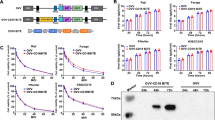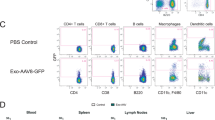Abstract
Purified, high-titer adenovirus encoding murine CD154 (Ad-CD154) or human CD154 (Ad-hCD154) was used to infect lymph node cells isolated from patients with follicle center lymphoma. Infection of lymphoma B cells with Ad-CD154 at a multiplicity of infection (MOI) ratio of 100 or higher resulted in high-level transgene expression. Additionally, upon infection of lymphoma B cells, only Ad-CD154 resulted in surface expression of CD154, despite similar, high-level expression of either human or mouse CD154 by HeLa cells infected with Ad-hCD154 or Ad-CD154, respectively. Moreover, infection of lymphoma B cells with Ad-CD154, but not Ad-hCD154 or adenovirus encoding Eschericheria coli beta-galactosidase (Ad-LacZ), induced the neoplastic B cells to express higher levels of immune co-stimulatory molecules that are required for proficient presentation of antigen to T cells. Consistent with this, we found that Ad-CD154 infected lymphoma B cells could stimulate T cells to proliferate or produce interferon-gamma in allogeneic or autologous mixed lymphocyte interactions. We conclude that lymphoma B cells can be infected with Ad-CD154 and that this significantly enhances their recognition by allogeneic or autologous T cells. As such, Ad-CD154-transduced lymphoma B cells may have potential for the active immune therapy of patients with follicle center lymphoma.
This is a preview of subscription content, access via your institution
Access options
Subscribe to this journal
Receive 12 print issues and online access
$259.00 per year
only $21.58 per issue
Buy this article
- Purchase on Springer Link
- Instant access to full article PDF
Prices may be subject to local taxes which are calculated during checkout








Similar content being viewed by others
References
Banchereau J, Bazan F, Blanchard D, Briere F, Galizzi JP, van Kooten C, Liu YJ, Rousset F, Saeland S . The CD40 antigen and its ligand Annu Rev Immunol 1994 12: 881–922
Laman JD, Claassen E, Noelle RJ . Functions of CD40 and its ligand, gp39 (CD40L) Crit Rev Immunol 1996 16: 59–108
Cantwell M, Hua T, Pappas J, Kipps TJ . Acquired CD40-ligand deficiency in chronic lymphocytic leukemia Nat Med 1997 3: 984–989
Castle BE, Kishimoto K, Stearns C, Brown ML, Kehry MR . Regulation of expression of the ligand for CD40 on T helper lymphocytes J Immunol 1993 151: 1777–1788
Hermann P, Blanchard D, de Saint-Vis B, Fossiez F, Gaillard C, Vanbervliet B, Briere F, Banchereau J, Galizzi JP . Expression of a 32-kDa ligand for the CD40 antigen on activated human T lymphocytes Eur J Immunol 1993 23: 961–964
Roy M, Waldschmidt T, Aruffo A, Ledbetter JA, Noelle RJ . The regulation of the expression of gp39, the CD40 ligand, on normal and cloned CD4+ T cells J Immunol 1993 151: 2497–2510
Ranheim EA, Kipps TJ . Activated T cells induce expression of B7/BB1 on normal or leukemic B cells through a CD40-dependent signal J Exp Med 1993 177: 925–935
Ranheim EA, Kipps TJ . Tumor necrosis factor-alpha facilitates induction of CD80 (B7–1) and CD54 on human B cells by activated T cells: complex regulation by IL-4, IL-10, and CD40L Cell Immunol 1995 161: 226–235
Grewal IS, Flavell RA . CD40 and CD154 in cell-mediated immunity Ann Rev Immunol 1998 16: 111–135
Mackey MF, Barth RJ Jr, Noelle RJ . The role of CD40/CD154 interactions in the priming, differentiation, and effector function of helper and cytotoxic T cells J Leukoc Biol 1998 63: 418–428
Aruffo A, Farrington M, Hollenbaugh D, Li X, Milatovich A, Nonoyama S, Bajorath J, Grosmaire LS, Stenkamp R, Neubauer M . The CD40 ligand, gp39, is defective in activated T cells from patients with X-linked hyper-IgM syndrome Cell 1993 72: 291–300
Korthauer U, Graf D, Mages HW, Briere F, Padayachee M, Malcolm S, Ugazio AG, Notarangelo LD, Levinsky RJ, Kroczek RA . Defective expression of T-cell CD40 ligand causes X-linked immunodeficiency with hyper-IgM Nature 1993 361: 539–541
Kato K, Cantwell MJ, Sharma S, Kipps TJ . Gene transfer of CD40-ligand induces autologous immune recognition of chronic lymphocytic leukemia B cells J Clin Invest 1998 101: 1133–1141
Wierda WG, Cantwell MJ, Woods SJ, Rassenti LZ, Prussak CE, Kipps TJ . CD40-ligand (CD154) gene therapy for chronic lymphocytic leukemia Blood 2000 96: 2917–2924
Dilloo D, Brown M, Roskrow M, Zhong W, Holladay M, Holden W, Brenner M . CD40 ligand induces an antileukemia immune response in vivo Blood 1997 90: 1927–1933
Kikuchi T, Crystal RG . Anti-tumor immunity induced by in vivo adenovirus vector-mediated expression of CD40 ligand in tumor cells Hum Gene Ther 1999 10: 1375–1387
Nakajima A, Kodama T, Morimoto S, Azuma M, Takeda K, Oshima H, Yoshino S, Yagita H, Okumura K . Antitumor effect of CD40 ligand: elicitation of local and systemic antitumor responses by IL-12 and B7 J Immunol 1998 161: 1901–1907
Schultze JL, Cardoso AA, Freeman GJ, Seamon MJ, Daley J, Pinkus GS, Gribben JG, Nadler LM . Follicular lymphomas can be induced to present alloantigen efficiently: a conceptual model to improve their tumor immunogenicity (published erratum appears in Proc Natl Acad Sci USA 1995; 92: 10818) Proc Natl Acad Sci USA 1995 92: 8200–8204
Schultze JL, Seamon MJ, Michalak S, Gribben JG, Nadler LM . Autologous tumor infiltrating T cells cytotoxic for follicular lymphoma cells can be expanded in vitro Blood 1997 89: 3806–3816
Hsu FJ, Benike C, Fagnoni F, Liles TM, Czerwinski D, Taidi B, Engleman EG, Levy R . Vaccination of patients with B-cell lymphoma using autologous antigen-pulsed dendritic cells Nat Med 1996 2: 52–58
Renschler MF, Wada HG, Fok KS, Levy R . B-lymphoma cells are activated by peptide ligands of the antigen binding receptor or by anti-idiotypic antibody to induce extracellular acidification Cancer Res 1995 55: 5642–5647
Cantwell MJ, Sharma S, Friedmann T, Kipps TJ . Adenovirus vector infection of chronic lymphocytic leukemia B cells Blood 1996 88: 4676–4683
Blanche F, Cameron B, Barbot A, Ferrero L, Guillemin T, Guyot S, Somarriba S, Bisch D . An improved anion-exchange HPLC method for the detection and purification of adenoviral particles Gene Therapy 2000 7: 1055–1062
Huyghe BG, Liu X, Sutjipto S, Sugarman BJ, Horn MT, Shepard HM, Scandella CJ, Shabram P . Purification of a type 5 recombinant adenovirus encoding human p53 by column chromatography Hum Gene Ther 1995 6: 1403–1416
Shabram PW, Giroux DD, Goudreau AM, Gregory RJ, Horn MT, Huyghe BG, Liu X, Nunnally MH, Sugarman BJ, Sutjipto S . Analytical anion-exchange HPLC of recombinant type-5 adenoviral particles Hum Gene Ther 1997 8: 453–465
Becker TC, Noel RJ, Coats WS, Gómez-Foix AM, Alam T, Gerard RD, Newgard CB . Use of recombinant adenovirus for metabolic engineering of mammalian cells Meth Cell Biol 1994 43: 161–189
Blossom S, Chu EB, Weigle WO, Gilbert KM . CD40 ligand expressed on B cells in the BXSB mouse model of systemic lupus erythematosus J Immunol 1997 159: 4580–4586
Clodi K, Asgary Z, Zhao S, Kliche KO, Cabanillas F, Andreeff M, Younes A . Coexpression of CD40 and CD40 ligand in B-cell lymphoma cells Br J Haematol 1998 103: 270–275
Desai-Mehta A, Lu L, Ramsey-Goldman R, Datta SK . Hyperexpression of CD40 ligand by B and T cells in human lupus and its role in pathogenic autoantibody production J Clin Invest 1996 97: 2063–2073
Schattner EJ, Mascarenhas J, Reyfman I, Koshy M, Woo C, Friedman SM, Crow MK . Chronic lymphocytic leukemia B cells can express CD40 ligand and demonstrate T-cell type costimulatory capacity Blood 1998 91: 2689–2697
Kato K, Santana-Sahagún E, Rassenti LZ, Weisman MH, Tamura N, Kobayashi S, Hashimoto H, Kipps TJ . The soluble CD40 ligand sCD154 in systemic lupus erythematosus J Clin Invest 1999 104: 947–955
Younes A, Snell V, Consoli U, Clodi K, Zhao S, Palmer JL, Thomas EK, Armitage RJ, Andreeff M . Elevated levels of biologically active soluble CD40 ligand in the serum of patients with chronic lymphocytic leukaemia Br J Haematol 1998 100: 135–141
Lane P, Traunecker A, Hubele S, Inui S, Lanzavecchia A, Gray D . Activated human T cells express a ligand for the human B cell-associated antigen CD40 which participates in T cell-dependent activation of B lymphocytes Eur J Immunol 1992 22: 2573–2578
Andersen NS, Larsen JK, Christiansen J, Pedersen LB, Christophersen NS, Geisler CH, Jurlander J . Soluble CD40 ligand induces selective proliferation of lymphoma cells in primary mantle cell lymphoma cell cultures Blood 2000 96: 2219–2225
Funakoshi S, Longo DL, Beckwith M, Conley DK, Tsarfaty G, Tsarfaty I, Armitage RJ, Fanslow WC, Spriggs MK, Murphy WJ . Inhibition of human B-cell lymphoma growth by CD40 stimulation Blood 1994 83: 2787–2794
Acknowledgements
These studies funded in part by PO1-CA81534, PO1-CA34233, and PO1-CA72103 from the NIH
Author information
Authors and Affiliations
Rights and permissions
About this article
Cite this article
Cantwell, M., Wierda, W., Lossos, I. et al. T cell activation following infection of primary follicle center lymphoma B cells with adenovirus encoding CD154. Leukemia 15, 1451–1457 (2001). https://doi.org/10.1038/sj.leu.2402208
Received:
Accepted:
Published:
Issue Date:
DOI: https://doi.org/10.1038/sj.leu.2402208
Keywords
This article is cited by
-
Rapid and efficient nonviral gene delivery of CD154 to primary chronic lymphocytic leukemia cells
Cancer Gene Therapy (2006)
-
Intratumoral administration of immature dendritic cells following the adenovirus vector encoding CD40 ligand elicits significant regression of established myeloma
Cancer Gene Therapy (2005)
-
Role for CD40L in the therapy of human cancer
Chinese Journal of Clinical Oncology (2005)
-
The role of CD40-CD154 interaction in cell immunoregulation
Journal of Biomedical Science (2004)
-
Prospects for CD40-directed experimental therapy of human cancer
Cancer Gene Therapy (2003)



